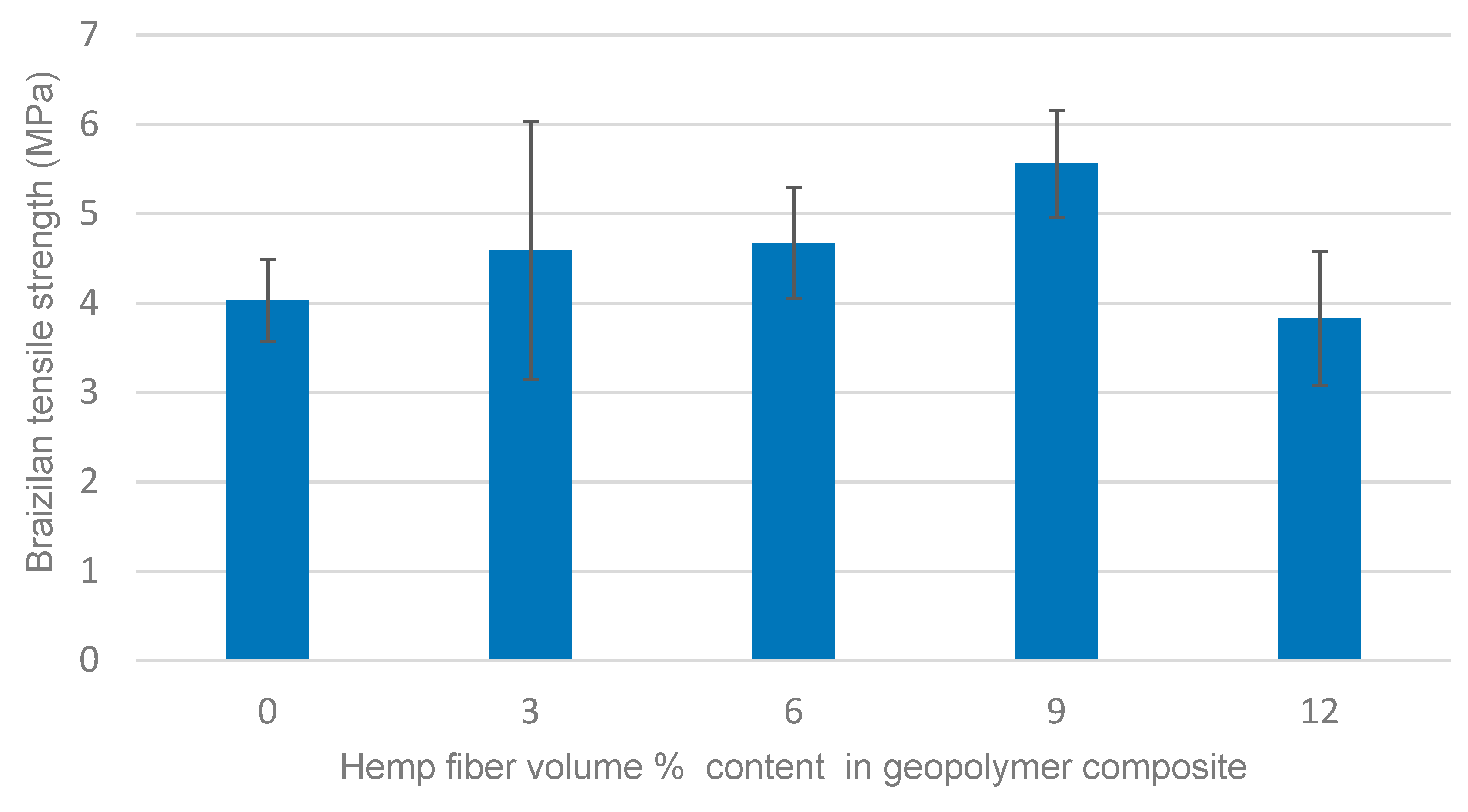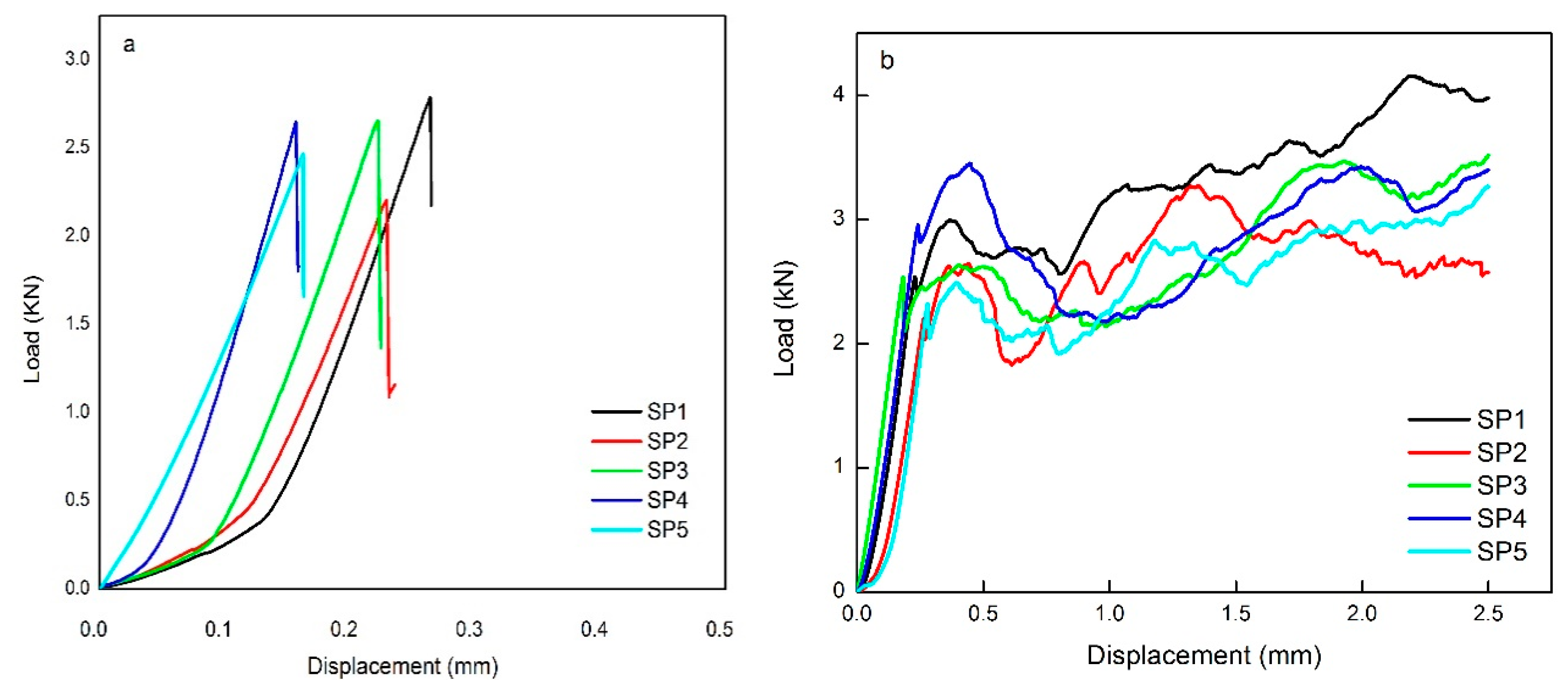Hemp Fiber Reinforced Red Mud/Fly Ash Geopolymer Composite Materials: Effect of Fiber Content on Mechanical Strength
Abstract
1. Introduction
2. Materials and Methods
2.1. Sample Preparation
2.2. Compressive Strength
2.3. Scanning Electron Microscopy (SEM)
2.4. Brazilian Tensile Strength Test
3. Results and Discussion
3.1. Compressive Strength
3.2. Brazilian Tensile Strength
3.3. Load versus Displacement Curves in Brazilian Tensile Strength Test
3.4. Scanning Electron Microscopy
4. Conclusions
Author Contributions
Funding
Institutional Review Board Statement
Informed Consent Statement
Data Availability Statement
Acknowledgments
Conflicts of Interest
References
- Koltun, P. Materials and sustainable development. Prog. Nat. Sci. 2010, 20, 16–29. [Google Scholar] [CrossRef]
- Marques, F.M.; Salgado, M.S. The Building Material Selection Importance at the Building Design Process for Its Sustainability. In Proceedings of the CIB World Building Congress Construction for Development, Cape Town, South Africa, 14–17 May 2007; Volume 14, p. 17. [Google Scholar]
- Owusu, P.A.; Asumadu-Sarkodie, S. A review of renewable energy sources, sustainability issues and climate change mitigation. Cogent Eng. 2016, 3, 1167990. [Google Scholar] [CrossRef]
- Usha, S.; Nair, D.G.; Vishnudas, S. Geopolymer Binder from Industrial Wastes: A Review. Int. J. Civ. Eng. Technol. 2014, 5, 219–225. [Google Scholar]
- Qu, M.; Hamdani, S.; Bunce, J.A. The physiology and genetics of stomatal adjustment under fluctuating and stressed environments. Appl. Photosynth. New Prog. 2016. [Google Scholar] [CrossRef]
- Madurwar, M.V.; Ralegaonkar, R.V.; Mandavgane, S.A. Application of agro-waste for sustainable construction materials: A review. Constr. Build. Mater. 2013, 38, 872–878. [Google Scholar] [CrossRef]
- Awoyera, P.; Adesina, A. Plastic wastes to construction products: Status, limitations and future perspective. Case Stud. Constr. Mater. 2020, 12, e00330. [Google Scholar] [CrossRef]
- Mohajerani, A.; Suter, D.; Jeffrey-Bailey, T.; Song, T.; Arulrajah, A.; Horpibulsuk, S.; Law, D. Recycling waste materials in geopolymer concrete. Clean Technol. Environ. Policy 2019, 21, 493–515. [Google Scholar] [CrossRef]
- Assi, L.; Carter, K.; Deaver, E.; Anay, R.; Ziehl, P. Sustainable concrete: Building a greener future. J. Clean. Prod. 2018, 198, 1641–1651. [Google Scholar] [CrossRef]
- Alehyen, S.; Achouri, M.E.L.; Taibi, M. Characterization, Microstructure and Properties of Fly Ash-Based Geopolymer. J. Mater. Environ. Sci. 2017, 8, 1783–1796. [Google Scholar]
- Huang, X.; Yu, L.; Li, D.W.; Shiau, Y.; Li, S.; Liu, K.X. Preparation and properties of geopolymer from blast furnace slag. Mater. Res. Innov. 2015, 19, S10-413–S10-419. [Google Scholar] [CrossRef]
- Das, S.K.; Mishra, J.; Mustakim, S.M. Rice Husk Ash as a Potential Source Material for Geopolymer Concrete: A. Int. J. Appl. Eng. Res. 2018, 13, 81–84. [Google Scholar]
- Ambrus, M.; Mucsi, G.; Szabó, R.; Kovács, B. The development of fly ash-red mud based geopolymer. Analecta Tech. Szeged. 2018, 12, 30–38. [Google Scholar] [CrossRef]
- Aswani, E.; Karthi, L. A Literature Review on Fiber Reinforced Geopolymer Concrete. Int. J. Sci. Eng. Res. 2017, 8, 408–411. [Google Scholar]
- Lyon, R.E.; Balaguru, P.; Foden, A.; Sorathia, U.; Davidovits, J.; Davidovics, M. Fire-Resistant Geopolymer Composites. In Proceedings of the First International Conference Fiber Composites in Infrastructure, Tucson, AZ, USA, 15–17 January 1996; pp. 972–981. [Google Scholar]
- Shill, S.K.; Al-Deen, S.; Ashraf, M.; Hutchison, W. Resistance of Fly Ash Based Geopolymer Mortar to Both Chemicals and High Thermal Cycles Simultaneously. Constr. Build. Mater. 2020, 239, 117886. [Google Scholar] [CrossRef]
- Papakonstantinou, C.G.; Balaguru, P.N. Geopolymer Protective Coatings for Concrete. In Proceedings of the International Sampe Symposium Exhibition, Baltimore, MD, USA, 3–7 June 2007, ISSN 0891-0138. [Google Scholar]
- Łach, M.; Korniejenko, K.; Mikuła, J. Thermal Insulation and Thermally Resistant Materials Made of Geopolymer Foams. Procedia Eng. 2016, 151, 410–416. [Google Scholar] [CrossRef]
- Jaya, N.A.; Abdullah, M.M.A.B.; Ahmad, R. Reviews on Clay Geopolymer Ceramic Using Powder Metallurgy Method. Mater. Sci. Forum 2014, 803, 81–87. [Google Scholar] [CrossRef]
- Singh, N.B. Fly Ash-Based Geopolymer Binder: A Future Construction Material. Minerals 2018, 8, 299. [Google Scholar] [CrossRef]
- Roviello, G.; Ricciotti, L.; Molino, A.J.; Menna, C.; Ferone, C.; Cioffi, R.; Tarallo, O. Hybrid Geopolymers from Fly Ash and Polysiloxanes. Molecules 2019, 24, 3510. [Google Scholar] [CrossRef]
- Li, Y.; Min, X.; Ke, Y.; Liu, D.; Tang, C. Preparation of red mud-based geopolymer materials from MSWI fly ash and red mud by mechanical activation. Waste Manag. 2019, 83, 202–208. [Google Scholar] [CrossRef]
- Ye, H.; Zhang, Y.; Yu, Z.; Mu, J. Effects of cellulose, hemicellulose, and lignin on the morphology and mechanical properties of metakaolin-based geopolymer. Constr. Build. Mater. 2018, 173, 10–16. [Google Scholar] [CrossRef]
- Alshaaer, M.; Abu Mallouh, S.; Al-Kafawein, J.; Al-Faiyz, Y.; Fahmy, T.; Kallel, A.; Rocha, F. Fabrication, microstructural and mechanical characterization of Luffa Cylindrical Fibre-Reinforced geopolymer composite. Appl. Clay Sci. 2017, 143, 125–133. [Google Scholar] [CrossRef]
- Korniejenko, K.; Łach, M.; Mikuła, J.; Fangueiro, R.; Rana, S. Advances in Natural Fibre Composites; Springer Science and Business Media LLC: Berlin, Germany, 2017; pp. 135–144. [Google Scholar]
- Camargo, M.M.; Taye, E.A.; Roether, J.A.; Redda, D.T.; Boccaccini, A.R. A Review on Natural Fiber-Reinforced Geopolymer and Cement-Based Composites. Materials 2020, 13, 4603. [Google Scholar] [CrossRef]
- Riahi, S.; Nazari, A.; Zaarei, D.; Khalaj, G.; Bohlooli, H.; Kaykha, M.M. Compressive strength of ash-based geopolymers at early ages designed by Taguchi method. Mater. Des. 2012, 37, 443–449. [Google Scholar] [CrossRef]
- Ravat, D.; Shah, S.; Dave, S. Utilization of Red Mud in Geopolymer Concrete-A Review. Int. J. Adv. Eng. Res. Dev. 2017, 4, 738–741. [Google Scholar]
- Singh, S.; Biswas, R.D.; Aswath, M.U. Experimental Study on Red Mud Based Geopolymer Concrete with Fly Ash & GGBS in Ambient Temperature Curing. Int. J. Adv. Mech. Civ. Eng. Issn 2016, 3, 2394–2827. [Google Scholar]
- Wuana, R.A.; Okieimen, F.E. Heavy Metals in Contaminated Soils: A Review of Sources, Chemistry, Risks and Best Available Strategies for Remediation. ISRN Ecol. 2011, 2011, 1–20. [Google Scholar] [CrossRef]
- Shahzad, A. Hemp fiber and its composites-a review. J. Compos. Mater. 2012, 46, 973–986. [Google Scholar] [CrossRef]
- Pervaiz, M.; Sain, M. Carbon storage potential in natural fiber composites. Resour. Conserv. Recycl. 2003, 39, 325–340. [Google Scholar] [CrossRef]
- Korniejenko, K.; Łach, M.; Hebdowska-Krupa, M.; Mikuła, J. The mechanical properties of flax and hemp fibres reinforced geopolymer composites. IOP Conf. Ser. Mater. Sci. Eng. 2018, 379, 012023. [Google Scholar] [CrossRef]
- Maichin, P.; Suwan, T.; Jitsangiam, P.; Chindaprasirt, P. Hemp Fiber Reinforced Geopolymer Composites: Effects of NaOH Concentration on Fiber Pre-Treatment Process. Key Eng. Mater. 2020, 841, 166–170. [Google Scholar] [CrossRef]
- Sikapizye, E.; Habanyama, A. Synthesis and characterization of hemp and flax fiber reinforced geopolymer composites. J. Chem. Eng. Mater. Sci. 2020, 11, 10–23. [Google Scholar] [CrossRef]
- Alomayri, T.; Low, I. Synthesis and characterization of mechanical properties in cotton fiber-reinforced geopolymer composites. J. Asian Ceram. Soc. 2013, 1, 30–34. [Google Scholar] [CrossRef]
- Ye, H.; Zhang, Y.; Yu, Z. Wood Flour’s Effect on the Properties of Geopolymer-based Composites at Different Curing Times. Bioresources 2018, 13, 2499–2514. [Google Scholar] [CrossRef]
- Assaedi, H.; Shaikh, F.; Low, I. Effect of nanoclay on durability and mechanical properties of flax fabric reinforced geopolymer composites. J. Asian Ceram. Soc. 2017, 5, 62–70. [Google Scholar] [CrossRef]
- Chen, R.; Ahmari, S.; Zhang, L. Utilization of sweet sorghum fiber to reinforce fly ash-based geopolymer. J. Mater. Sci. 2013, 49, 2548–2558. [Google Scholar] [CrossRef]





| Chemical Composition (in wt %) | SiO2 | Al2O3 | Fe2O3 | CaO | Na2O | K2O | TiO2 | Loss of Ignition |
|---|---|---|---|---|---|---|---|---|
| Fly ash (%) | 54.36 | 24.84 | 8.28 | 2.56 | 0.83 | 3.03 | 1.07 | 2.04 |
| Red mud (%) | 5.21 | 15.21 | 52.94 | 2.65 | 2.40 | 0.63 | 8.05 | 10.77 |
Publisher’s Note: MDPI stays neutral with regard to jurisdictional claims in published maps and institutional affiliations. |
© 2021 by the authors. Licensee MDPI, Basel, Switzerland. This article is an open access article distributed under the terms and conditions of the Creative Commons Attribution (CC BY) license (http://creativecommons.org/licenses/by/4.0/).
Share and Cite
Taye, E.A.; Roether, J.A.; Schubert, D.W.; Redda, D.T.; Boccaccini, A.R. Hemp Fiber Reinforced Red Mud/Fly Ash Geopolymer Composite Materials: Effect of Fiber Content on Mechanical Strength. Materials 2021, 14, 511. https://doi.org/10.3390/ma14030511
Taye EA, Roether JA, Schubert DW, Redda DT, Boccaccini AR. Hemp Fiber Reinforced Red Mud/Fly Ash Geopolymer Composite Materials: Effect of Fiber Content on Mechanical Strength. Materials. 2021; 14(3):511. https://doi.org/10.3390/ma14030511
Chicago/Turabian StyleTaye, Eyerusalem A., Judith A. Roether, Dirk W. Schubert, Daniel T. Redda, and Aldo R. Boccaccini. 2021. "Hemp Fiber Reinforced Red Mud/Fly Ash Geopolymer Composite Materials: Effect of Fiber Content on Mechanical Strength" Materials 14, no. 3: 511. https://doi.org/10.3390/ma14030511
APA StyleTaye, E. A., Roether, J. A., Schubert, D. W., Redda, D. T., & Boccaccini, A. R. (2021). Hemp Fiber Reinforced Red Mud/Fly Ash Geopolymer Composite Materials: Effect of Fiber Content on Mechanical Strength. Materials, 14(3), 511. https://doi.org/10.3390/ma14030511







